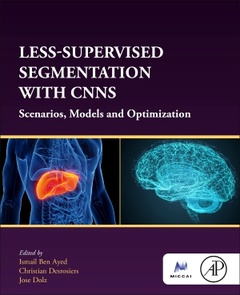Less-Supervised Segmentation with CNNs Scenarios, Models and Optimization The MICCAI Society book Series
Coordonnateurs : Dolz Jose, Ben Ayed Ismail, Desrosiers Christian

Less-Supervised Segmentation with CNNs: Scenarios, Models and Optimization reviews recent progress in deep learning for image segmentation under scenarios with limited supervision, with a focus on medical imaging. The book presents main approaches and state-of-the-art models and includes a broad array of applications in medical image segmentation, including healthcare, oncology, cardiology and neuroimaging. A key objective is to make this mathematical subject accessible to a broad engineering and computing audience by using a large number of intuitive graphical illustrations. The emphasis is on giving conceptual understanding of the methods to foster easier learning.
This book is highly suitable for researchers and graduate students in computer vision, machine learning and medical imaging.
2. Preliminaries
3. Different levels of supervision
4. Semi-supervised learning
5. Unsupervised domain adaptation
6. Weakly supervised segmentation
7. Few-shot learning
8. Unsupervised segmentation
9. Perspectives and future directions
Ismail Ben Ayed received a Ph.D. degree (with the highest honor) in the area of computer vision from the National Institute of Scientific Research (INRS-EMT), University of Quebec, Montreal, QC, Canada, in May 2007, under the guidance of Professor Amar Mitiche. Since then, he has been a research scientist with GE Healthcare, London, ON, Canada, conducting research in medical image analysis. He also holds an Adjunct Professor appointment at Western University, department of Medical Biophysics. He co-authored a book, over 50 peer-reviewed papers in reputable journals and conferences, and six patents. He received a GE recognition award in 2012 and a GE innovation award in 2010
Ismail Ben Ayed is an image segmentation and optimization expert who has authored over 60 peer-reviewed articles in the field and has co-authored the book Variational and Level Set Methods in Image Segmentation, 2011, which is receiving a high citation rate.
Christian Desrosiers,
Since 2009 Christian Desrosiers has worked as an assistant professor in the Software and IT Engineering department at ÉTS, Montreal. Before joining the department, he was a postdoctoral research assistant at the University of Minnesota, under the supervi
- Presents a good understanding of the different weak-supervision models (i.e., loss functions and priors) and the conceptual connections between them, providing an ability to choose the most appropriate model for a given application scenario
- Provides knowledge of several possible optimization strategies for each of the examined losses, giving the ability to choose the most appropriate optimizer for a given problem or application scenario
- Outlines the main strengths and weaknesses of state-of-the-art approaches
- Gives the tools to understand and use publicly-available code, as well as customize it for specific objectives
Date de parution : 12-2024
Ouvrage de 275 p.
19x23.3 cm
